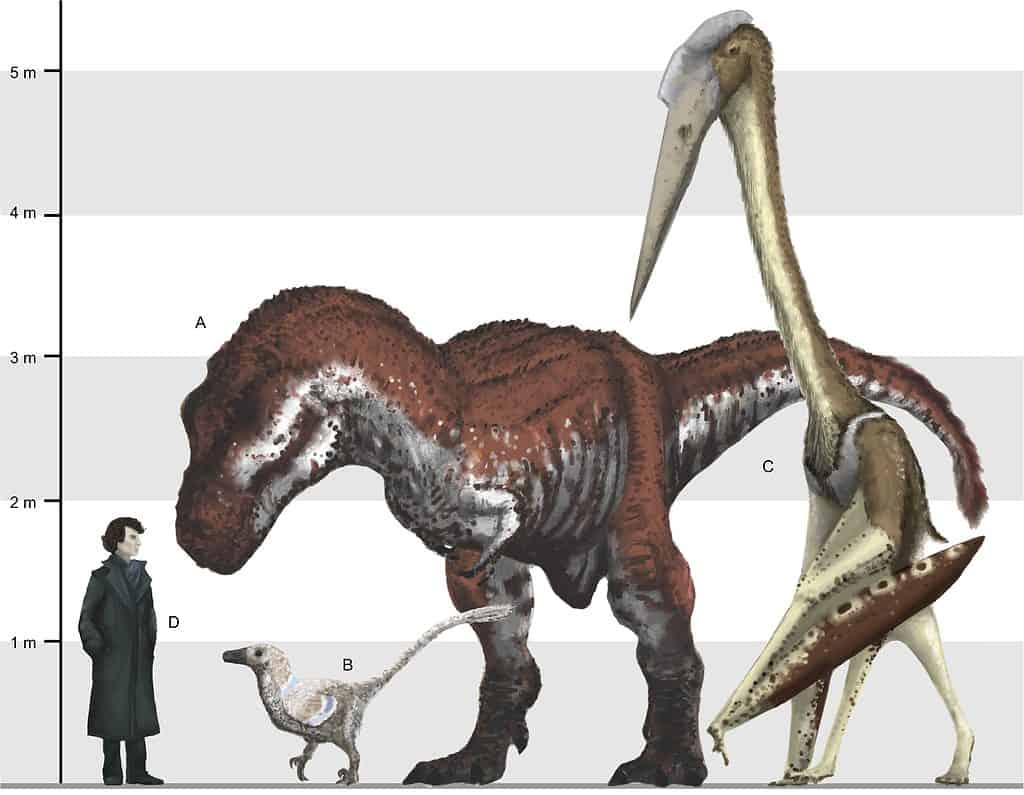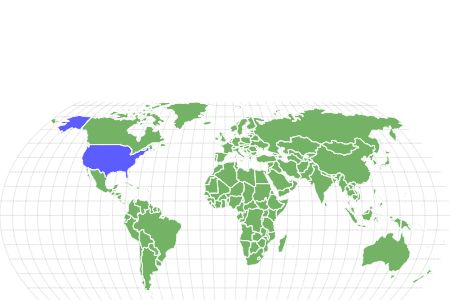The Arambourgiania was not a dinosaur but instead a pterosaur!
Advertisement
Arambourgiania Scientific Classification
- Kingdom
- Animalia
Read our Complete Guide to Classification of Animals.
Arambourgiania Conservation Status
Arambourgiania Facts
- Fun Fact
- The Arambourgiania was not a dinosaur but instead a pterosaur!
- Most Distinctive Feature
- Long extended neck
- Wingspan
- 25-30 feet
View all of the Arambourgiania images!
The Arambourgiania was a huge stork-like reptile. It had a wingspan of 25 to 30 feet and was three times taller than a human male!
The Arambourgiania was a flying reptile. It lived from 66 to 77 million years ago during the Late Cretaceous period, alongside many other dinosaurs and pterosaurs. Belonging to the Azharchids family, Arambourgiania was largely found in modern-day Middle East. So far, only 2 fossil specimens have been discovered for this species. We still have much to learn about this giant pterosaur!
Scientific Name
Arambourgiania
Back in the 1940s, a specimen of the species was discovered in Jordan. This species had skinny, thin-walled bones, about 24 inches long which pointed towards the fact that it as a flying reptile. Arambourgiania was originally named by Camille Arambourg in 1959 as Titanopteryx philadelphiae meaning “titan wing” in Greek. However, it was later discovered in the eighties that the name Titanopteryx was already taken by a species of fly. A paleontologist, Lev Nesov, renamed it Arambourgiania after the paleontologist Arambourg who named it in the first place.
Description & Size

Two paleontologists, Frey and Martill, also estimated that the Arambourgiania had a wingspan of about 35 to 45 feet, or about as long as a yellow school bus.
©2,163 × 1,682 pixels, file size: 1.67 MB, MIME type: image/png – License
Arambourgiania had an extremely long cervical vertebra, which was originally thought to be 24 inches long in the first sample. It was later discovered that this vertebra was missing some parts. The total length might have been 30 to 35 inches long. These bones were very thin and light.
Paleontologists have determined that the neck length was about 10 feet long. Two paleontologists, Frey and Martill, also estimated that the Arambourgiania had a wingspan of about 35 to 45 feet, or about as long as a yellow school bus. Thus, at the time, it was concluded that the Arambourgiania was the largest known pterosaur. Over the years, these estimates became smaller and eventually reduced to 20 to 25 feet. But by 2010, it was finally decided that the Arambourgiania’s wingspan was between 25 to 30 feet.
These reptiles had elongated beaks and were quite tall as well. They were almost three times the height of an average American male. Their beaks had no teeth, so they tackled their prey by grabbing them and swallowing them hole.
Diet – What Did The Arambourgiania Eat?
The Arambourgiania was a carnivore that ate only meat. They hunted prey on the ground as and caught fish and seacreatures in shallow waters. Thus, their diet included fish, amphibians, lizards, and even baby dinosaurs. This lifestyle was typical to the entire family of Azharchids. Therefore, data about the diet of the Arambourgiania is largely based on the general data of what scientists believe the Azharchids family ate.
Habitat – When And Where It Lived
The Arambourgiania lived in a semi-aquatic environment, particularly in areas of modern-day Middle East and the United States. They lived in the Late Cretaceous Period, from around 66 to 77 million years ago. Evidence showed that these flying lizards preferred to live primarily on land near the water for easy access to food. However, their padded feet suggested that these animals would also have spent some time in shallow waters, such as rivers, streams, and lakes.
Threats And Predators
One of the possible predators of the Arambourgiania was thought to be the Hatzegopteryx, a member of the Azhdarchids family. Since the Hatzegopteryx was much larger in size than the Arambourgiania. In fact it was the largest flying animal to ever live and was apex predator at the time. In addition, other large predators living at the time, such as the Tyrannosaurs or the Spinosaurids, were also possible threats to the survival of Arambourgiania.
While the Arambourgiania’s predators are not clear even today, there were several other species that might have competed with them for food and other resources within the habitat. Other threats to the population of the Arambourgiania could have been ocean acidification, rise in global temperatures, and weather changes within the habitat.
Discoveries and Fossils – Where It Was Found
The first fossil sample of the Arambourgiania was discovered in the 1940s. This was during the repairs of the Amman-Damascus railway line in Jordan. This sample was initially thought to be part of the animal’s metacarpal. It later turned out to be the cervical vertebra. A plaster cast was made of this sample in Paris. Unfortunately, the original fossil is lost today.
Another sample of the reptile’s bones was found in a rather interesting discovery. The office of the Jordan Phosphate Mines Company had many bones hidden in one of their cabinets, which later turned out to be Arambourgiania bones.
In 2016, another sample was discovered in the Coon Creek Formation of McNairy County, Tennessee, and was called Arambourgiania philadelphiae. So, this extended the geographical range of the Arambourgiania to North America.
Other possible samples were also found in Germany in 2018, which seemed similar to those of the Arambourgiania that were found in the 1940s, but they have yet to be officially confirmed.
Extinction – When Did It Die Out?
The Arambourgiania lived from around 66 to 77 million years ago. They went extinct in the Late Cretaceous Period, around the time when a mass extinction event wiped out 75% of the animal population on earth. One popular theory for this sudden mass extinction event is that an massive asteroid collided with the planet. Clay debris and a layer of sediment all over the Earth point to that. As a result of this asteroid incident, a cloud of dust began to hover in the sky, affecting the climate all over the planet. The cloud prevented sunlight, resulting in extremely cold temperatures. These temperatures wiped out most of the lifeforms on earth. This was the last major mass extinction event to happen on our planet.
Similar Animals To The Arambourgiania
There are several animals that were similar to Arambourgiania, living during various eras. Some of these animals include:
Storks – Just like the Arambourgiania, storks today have an extended neck, an outward beak, and wings on both sides of their bodies. However, storks are much smaller than the Arambourgiania and are covered in feathers.
Giraffes – Another modern-day animal with a similar body structure to the Arambourgiania, the giraffes have a long extended neck, front legs longer than the hind ones, and an upright posture. The main point of difference between these two animals is that giraffes cannot fly like the Arambourgiania.
Pterodactylus – A relatively smaller pterosaur, these were medium-sized birds that have a beak and wingspan that mimicked that of the Arambourgiania.
Pteranodon – Pteronadons had a similar wing structure to Arambourgiania and were seen and featured in several Jurassic movies.
Related Animals
View all 194 animals that start with AArambourgiania FAQs (Frequently Asked Questions)
When was the Arambourgiania alive?
The Arambourgiania was alive 66 to 77 million years ago, during the Late Cretaceous period.
How big was the Arambourgiania?
The Arambourgiania was almost three times the average human height at about 16 feet tall. It also had an impressive wingspan of 25 to 30 feet.
Why did the Arambourgiania die out?
The Arambourgiania are thought to have died out during the Cretaceous-Paleogene mass extinction event, when an asteroid hit the earth, and the sky was clouded by dust, causing a long winter due to the lack of sunlight.
Was the Arambourgiania herbivorous, carnivorous, or omnivorous?
The Arambourgiania was an carnivorous reptile that fed on smaller animals that lived in its habitat. They lived semi-aquatic lifestyles, so they fed on fish, other reptiles, and amphibians.
Were there any predators of the Arambourgiania?
The exact details of the Arambourgiania predators are unknown. However, any larger carnivorous or even omnivorous animals in their habitat could have been predators of this reptile. Potential predators might have included the Tyrannosaurs or the Spinosaurids.
Thank you for reading! Have some feedback for us? Contact the AZ Animals editorial team.
Sources
- , Available here: https://dinosaurpictures.org/Arambourgiania-pictures
- , Available here: http://www.prehistoric-wildlife.com/species/a/arambourgiania.html
- , Available here: https://www.pteros.com/pterosaurs/arambourgiania.html
- , Available here: https://blogs.scientificamerican.com/tetrapod-zoology/some-azhdarchid-pterosaurs-were-robust-necked-top-tier-predators/

















